In an enlightening stride towards understanding the complexities of non-small cell lung cancer (NSCLC), recent research has unveiled the critical role of VISTA (V-domain Ig suppressor of T cell activation) expressed on tumor cells. This dynamic molecule has been identified as a regulatory player in the immune microenvironment, intricately linked to m6A methylation and downstream signaling pathways that significantly affect immune responses. The study, led by researchers Xu, Shen, and Jiang, brings to light the pivotal mechanisms at play in tumor immunology, offering new perspectives on potential therapeutic strategies for combating NSCLC.
The findings indicate that VISTA functions as an immune checkpoint molecule, which modulates the activity of immune cells in the tumor microenvironment. This modulation is facilitated by the regulation of m6A, a common RNA modification that influences gene expression and stability. Research has demonstrated that altered m6A methylation patterns can lead to significant differences in the expression of immune checkpoints like VISTA. The implications of this regulatory mechanism are profound, particularly in a disease as aggressive as NSCLC, where immune evasion is a critical characteristic of tumor growth and metastasis.
At the heart of the study is the intricate interplay between m6A methylation, VISTA expression, and the immune response orchestrated by STAT3 signaling pathways. The researchers identified that the activation of STAT3 was critical for the expression of CCL22, a chemokine that recruits and activates regulatory T cells (Tregs). Tregs play a crucial role in dampening the immune response against tumors, thus promoting an environment conducive to cancer progression. By elucidating these pathways, the researchers provide a clearer understanding of how tumors can manipulate immune responses to their advantage.
As NSCLC remains a leading cause of cancer-related mortality worldwide, the identification of VISTA as a modulator of immune responses highlights a potential target for immunotherapy. Therapies aimed at inhibiting VISTA could have significant implications for enhancing the effectiveness of existing treatments, such as checkpoint inhibitors that target PD-1/PD-L1 pathways. The ability to harness the intrinsic capabilities of the immune system to combat cancer is a cornerstone of modern oncology, and this discovery adds a new dimension to that pursuit.
Moreover, the study contributes to the ever-expanding field of epitranscriptomics, focusing on how RNA modifications influence cellular functions in health and disease. The implications of m6A modification extend beyond NSCLC, potentially impacting various malignancies and other diseases. Understanding the broader consequences of m6A methylation and its interplay with immune modulation could lead to the development of novel strategies aimed at reprogramming immune responses to combat a variety of cancers effectively.
The research also sparks critical discussions regarding the functional implications of tumor-immune interactions. It raises questions about the nature of immune cell infiltration in tumors expressing VISTA and how this expression correlates with clinical outcomes in NSCLC patients. The findings suggest that assessing VISTA levels alongside other immune checkpoints could offer insights into patient prognosis and treatment responses, paving the way for more personalized approaches to cancer therapy.
Furthermore, the investigation into the role of CCL22 in the context of NSCLC adds another layer of complexity to our understanding of tumor-immune dynamics. The ability of tumors to induce Treg accumulation through chemokines like CCL22 highlights the strategic maneuvers employed by cancer cells to escape immune detection. It beckons further exploration into the mechanisms behind Treg recruitment and the functional consequences of their presence within the tumor microenvironment, which could potentially inform future therapeutic targets.
As the study by Xu, Shen, and Jiang gains traction within the scientific community, it is likely to attract attention not only for its immediate findings but also for its overarching implications in cancer biology. The prospect of targeting VISTA and its regulatory pathways presents a tantalizing opportunity for researchers and clinicians alike. It accentuates the need for more comprehensive studies that can validate these findings in larger cohorts and different cancer types.
In conclusion, the research uncovering the role of VISTA expressed on tumor cells as a mediator of immune responses in NSCLC marks a significant advancement in the field of cancer immunology. As scientists continue to unravel the complexities of tumor-intrinsic mechanisms that facilitate immune evasion, the potential for novel therapeutic strategies expands. The integration of these findings into clinical oncology may hold the key to transforming the landscape of cancer treatment, with the hope of enhancing patient outcomes and survival rates in the battle against this devastating disease.
In an era of rapid advancements in cancer research, every discovery builds upon previous knowledge, leading to new horizons in treatment strategies. The interplay between RNA modifications like m6A, immune checkpoints such as VISTA, and the broader immune landscape underscores the complexity of the tumor microenvironment and the multifaceted approaches necessary to tackle cancer effectively. These findings not only inform ongoing research but also inspire optimism for developing innovative therapies that harness the immune system’s full potential.
The study underscores the importance of continued exploration into the regulatory mechanisms that govern immune system interactions with tumors. As researchers delve deeper into the nuances of these pathways, we may witness the emergence of new modalities that could redefine the standard of care for lung cancer patients and potentially those afflicted by other malignancies.
The evolving narrative around cancer therapy is one of collaboration, with diverse disciplines coming together to shed light on the intricacies of tumor biology. The insights gleaned from this research are crucial for driving forward the next generation of immunotherapies and biomarker development, signaling a brighter future for patients combating the realities of non-small cell lung cancer.
The implications of this research extend beyond the laboratory, offering a promise of hope to the thousands of patients battling this formidable disease. By understanding how tumors manipulate their microenvironment, researchers can better strategize and develop tailored therapies that can outsmart the cunning adaptations of cancer cells. The pursuit of innovative treatments based on this foundational research could lead to transformative changes in the treatment landscape for NSCLC.
In summary, the incisive work by Xu, Shen, Jiang, and their colleagues illuminates pathways previously shrouded in mystery within NSCLC. This is not merely an academic inquiry; it is a clarion call for further investigation into immune modulation in cancer, urging the scientific community to unite in a multifaceted approach to conquer the challenges posed by this disease. The findings serve as a beacon, guiding future research and fostering hope for improved therapeutic strategies that can ultimately save lives.
Subject of Research: The role of VISTA expressed on tumor cells in regulating the immune microenvironment in non-small cell lung cancer (NSCLC).
Article Title: VISTA expressed on tumor cells is regulated by m6A and influences immune microenvironment through STAT3/CCL22 in NSCLC.
Article References:
Xu, H., Shen, K., Jiang, B. et al. VISTA expressed on tumor cells is regulated by m6A and influences immune microenvironment through STAT3/CCL22 in NSCLC.
J Transl Med 23, 1043 (2025). https://doi.org/10.1186/s12967-025-06818-3
Image Credits: AI Generated
DOI:
Keywords: VISTA, m6A, immune microenvironment, non-small cell lung cancer, STAT3, CCL22, tumor immunology, immunotherapy.
Tags: immune checkpoint molecules in cancerimmune evasion in non-small-cell lung cancerm6A effects on gene expression in tumorsm6A methylation and immune responseNSCLC immune microenvironmentRNA modifications in cancerrole of immune checkpoints in NSCLCsignaling pathways in tumor immunitytherapeutic implications of VISTA researchtumor immunology and treatment strategiesVISTA and T cell activationVISTA regulation in tumor cells





